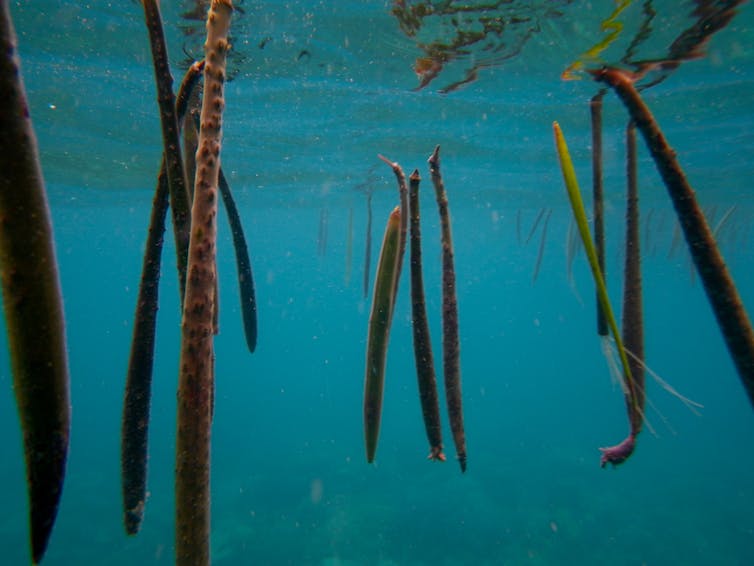|
The MAP News |
|
|
FEATURE STORY
Marvellous Mangroves – In-depth Ecotourism
 USA - During the past two decades there has been a steady growth in mangrove ecotourism as more and more people people discover the hidden beauties of the world’s mangrove forests. As selected parts of the Marvellous Mangroves curriculum have been used to supplement the knowledge of the guides, the concerted focus of the October mangrove tourism workshops held this year in Suriname have added a new dimension to the tour guide training process. MAP Education Director Martin Keeley joined forces with the United Tour Guides Association of Suriname (UTGS) and the Foundation for Development of Radio and TV in Suriname (SORTS) to hold two workshops. The first 3-day workshop was held in Coronie, home of the amazing Mangrove Education Centre, and the second in New Amsterdam, Commewijne, on the opposite side of the Suriname River to Paramaribo. In 2016 UTGS directors led by Errol Gezius and Yves Tjon, together with Sherida Mormon of the NGO Advice For Innovation & Business Creation (ABIC) took part in a teacher/student MM workshop in Coronie as well as a one-day introductory tour guide mangrove workshop led by Martin Keeley. This began the drive towards a second series of workshops in July, 2017, which are part of the training of young eco-tour guides in the Coronie region of Suriname. READ MORE AFRICA Indigenous communities urge governments to support their biodiversity conservation initiatives KENYA - Indigenous communities’ own conservation practices are vital to biodiversity conservation, said two new reports launched by communities in Kenya and Ghana. These are part of a series of reports from 12 countries by the Global Forest Coalition’s Community Conservation Resilience Initiative (CCRI), which strives to influence policy-makers about indigenous/local communities’ role in protecting biodiversity, showing the threats they face, and pushing for greater policy support for their efforts. In Kenya, the Maasai peoples and the Rendille peoples, both pastoralist communities have lived in harmony with wildlife and conserved the forests through customary laws and values. For instance, in Kenya’s Nyekweri Kimintet Forest, which borders the famous Maasai Mara National Park, community members have given up their private land to form the 6000 acre Nyekweri Forest Kimintet Trust, to conserve this key elephant breeding site and prevent land being converted for other uses. In Ghana, all three communities are part of the Ewe ethnic group, which conserves nature through sacred groves and sites, taboos, totems, observations and practices. These help to safeguard critical ecosystems and endemic species, helping to halt deforestation outside forest reserves. However, community members in both countries have also identified serious threats to their territories and conservation efforts. For example in Ghana, extractive industries were identified as a major problem. Community members from Avuto, which is the only home to the threatened Sitatunga (an amphibious antelope species) described how their territory has been opened up to oil and gas extraction by multinational companies.READ MORE ASIA Mangroves still dying at Iloilo River PHILIPPINES - Mangroves, aged 10 to 20 years, are continuously dying at a government esplanade project here despite assurances of different agencies that they will protect the trees. Marine scientist and mangrove specialist Jurgenne Primavera lamented the “gradual but wholesale killing of mangroves” along the Iloilo River. She said mangrove patches were being destroyed as materials dredged from the river were dumped into these areas, covering the mangroves’ roots. The opening of the culverts were blocked by debris, preventing tidal flow to the mangroves, Primavera said. The culverts are being built as part of the Iloilo River Esplanade project, which consists of a series of lateral parks put up on both sides of the river from Carpenter’s Bridge in Molo District to Barangay Nabitasan in La Paz District. When completed, the P488-million esplanade will stretch 7.5 kilometers, with a width of 5 meters. The completed sections of the lateral park have become a tourist destination and popular recreation area for residents and tourists. But environmentalists have appealed to government agencies to prioritize the protection of the environment over development projects. READ MORE Activists concerned over destruction of mangroves in non-forest land INDIA - Even as 2017’s Forest Survey of India (FSI) report revealed that Maharashtra’s mangrove cover increased by 82 sq km, activists have raised concerns over the destruction of mangroves in areas that are not under the jurisdiction of the forest department. “While the efforts of the Mangrove Cell in conserving mangroves are worth mentioning, the report does not mention if the increase is in forest land or other private land. If the report mentions separate figures for both, we will get a clear picture. The destruction will never happen in forest land, due to strict laws and continuous monitoring. It is mostly happening in revenue land,” said Harish Pandey, who has been fighting for the protection of mangroves in the Dahisar belt. Debi Goenka, executive trustee of the Conservation Action Trust (CAT), agreed. “According to the October 2005 High Court order, all government land should be notified as protected and handed over to the forest department, but it has still not been done so far. Land with different government agencies such as CIDCO, MMRDA, and so on, have still not been handed over as there are different proposals for them. The forest department has also not been active in demanding it back,” he said. READ MORE AMERICAS Mangroves protect coastlines, store carbon – and are expanding with climate change  USA - With the help of technology, humans can traverse virtually every part of our planet’s surface. But animals and plants are less mobile. Most species can only live in zones where temperature and rain fall within specific ranges. As regions become warmer due to climate change, plants and animals in those areas will either move to more appropriate climates or be replaced by newcomers who are well-suited to the new conditions. These changes are already occurring. For example, many plants, animals and birds in the Northern Hemisphere have shifted their ranges northward.Working with other ecologists in the shadow of the huge launch complex at Florida’s Kennedy Space Center, we have found that mangroves have increased in abundance by 70 percent in just seven years over an area of 220 square miles (567 square kilometers). This is a dramatic change in the plant community along this stretch of the Atlantic coast. Unlike many other impacts of climate change, we expect these shifting ranges to produce some benefits, including increased carbon storage and storm surge protection. READ MORE In the rush for landscape restoration goals, let’s not forget about biodiversity  USA - The global momentum for restoration has never been greater. With ambitious targets like the Bonn Challenge, New York Declaration and those set by the Convention on Biological Diversity, plus billions of dollars invested annually, countries all over the world are rapidly moving forward with Forest Landscape Restoration (FLR) initiatives as a way to address ecosystem conservation, sustainable development and climate goals. But even with forest ecosystems as a central focus for restoration in many countries, biodiversity has not received adequate attention in plans and action to meet global targets, according to a group of experts who took part in a forum on biodiversity and FLR held in Foz do Iguazu, Brazil, convened by the Society for Ecological Restoration (SER) and the International Union for Conservation of Nature (IUCN) CEM Thematic Group. During a full day of discussions, participants representing some of the most active organizations in landscape restoration science and practice agreed that there is a clear need to expand the decision space for FLR to include a wider range of ecosystem components in the evaluation of restoration needs. They noted that several national policies, associated incentives and monitoring actions that aim to meet restoration targets do not always favor biodiversity-friendly outcomes. READ MORE Study shows wetlands provide landscape-scale reduction in nitrogen pollution  USA - In agricultural regions such as the U.S. Midwest, excess nitrate from crop fertilizer makes its way into rivers and streams through subsurface drainage channels and agricultural ditches. High nitrate concentrations in waterways can be harmful to ecosystems and human health, contaminating drinking water and eventually flowing downstream far enough to increase the size of the Gulf of Mexico's "dead zone.” A study published today in the journal Nature Geoscience by National Science Foundation (NSF)-funded researchers offers new insights into this problem: Multiple wetlands, or "wetland complexes" in a watershed, are extremely effective at reducing nitrate levels in rivers and streams. Wetland complexes can be five times better at reducing nitrate than the best land-based nitrogen mitigation strategies, the scientists say."Agricultural productivity benefits the economy, but is often accompanied by environmental costs," says Tom Torgersen, director of NSF's Water, Sustainability and Climate program, which funded the research. "This study demonstrates that retaining or restoring wetlands in intensively managed agricultural watersheds would reduce nitrate in rivers and improve local water quality, while also reducing nitrate exports to the Gulf of Mexico hypoxic [dead] zone.” READ MORE OCEANA Mangrove bill sidesteps Resource Management Act  NEW ZEALAND - A local bill currently open for public submissions would give Thames-Coromandel and Hauraki districts the ability to remove mangroves without resource consent. The proposed Mangrove Management Bill, brought before Parliament by National’s MP for Coromandel, Scott Simpson, would allow the two councils to develop and implement a mangrove management plan. There have been past cases where exemptions to the Resource Management Act (RMA) processes have been made. These have been for disaster recovery efforts, such as the Canterbury Earthquake Recovery Act. Unlike the proposed Bill, these acts have had a narrow purpose. At the Bill’s first reading Simpson said the topic of mangroves had created angst and heartache within the community. Some residents see mangroves as impeding the recreational use of the harbour, while others see mangroves as important for ecology. READ MORE LAST WORD Dear Alfredo, We would like to thank you again for being a panelist for the "Coastal Infrastructure, Extreme Weather Events, Green Infrastructure and Blue Carbon" session of the World Ocean Council’s 5th “Sustainable Ocean Summit” (SOS 2017) in Halifax. The SOS 2017 wouldn't have been possible without your participation, presentation, and expertise. Thanks to your involvement, the SOS 2017 was a solid success. The event brought together over 225 ocean leaders from across the ocean industry sectors and stakeholder communities from around the world, with 28 nationalities represented. We hope the presentations, panels and discussions sparked by the different SOS sessions were valuable for you. We also hope that the SOS increased your understanding of the important, unique role of WOC in bringing together the diverse ocean business community (and other stakeholders) to focus on the challenges and opportunities of ocean sustainable development. With this in mind, we hope that you will let your peers and colleagues know about the important mission and efforts of the WOC and the unique role and value of the SOS in bringing the ocean business community and stakeholders together. We warmly invite you to participate in the 6th Sustainable Ocean Summit (Hong Kong, 14-16 November 2018), which is already shaping up to raise the bar further on international business leadership and collaboration for ocean sustainable development. Best regards, Paul Holthus, Christine Valentin, World Ocean Council |
MANGROVES APP AVAILABLE
|
Mangrove Action ProjectClick here to view past newsletters |
|
Mangrove Action Project's mission is to empower communities worldwide to restore, manage, and conserve mangrove forests. Through science, training, and environmental education, we provide nature-based solutions for people and our planet. MAP newsletter brings you news you can use: stories from around the globe pertaining to mangroves and the people who rely on them. To search a database of all MAP blogposts over the past 30 years, enter text in the box below. Thank you for loving the mangroves!





No comments:
Post a Comment
Note: Only a member of this blog may post a comment.